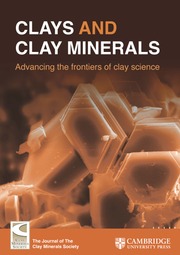Article contents
Synthesis and Characterization of Zeolites in the System Na2O-K2O-Al2O3-SiO2-H2O
Published online by Cambridge University Press: 02 April 2024
Abstract
Zeolites having the structures of phillipsite, merlinoite, and gobbinsite were synthesized from clear solutions at 80°C in the system Na2O-K2O-Al2O3-SiO2-H2O and their morphologies, cell parameters, and compositions determined. At 3.5 M silica concentration, the formation of merlinoite (synthetic zeolite W) is favored over the formation of phillipsite (synthetic zeolite ZK-19) by solution conditions of high pH (> 13.6) and low Na/(Na + K) ratios (<0.5).
Using the information obtained from the synthesis experiments, the presence of merlinoite was predicted in sediments from Searles Lake, a saline, alkaline lake in California with ideal physiochemical conditions for its formation. Merlinoite was subsequently discovered to occur in tuffaceous sediments as part of an authigenic silicate zonation pattern from phillipsite → phillipsite + merlinoite → merlinoite → K-feldspar with increasing depth. Because of the close similarities in the physical properties of phillipsite and merlinoite, merlinoite may be much more common as an authigenic mineral than is currently realized.
Резюме
Цеолиты, имеющие структуры филлипсита, мерлиноито и гоббинсито, синтезировались из чистых растворов при 80°С в системе Na2O-K2O-Al2O3-SiO2-H2O. Определялись морфологии, пара¬метры ячейки и состав этих материалов. При концентрации кремнезема равной 3,5 М, образование мерлиноита (синтетического цеолита W) происходило легче, чем образование филлипсита (синте¬тического цеолита ZK-19) в условиях раствора при высоком pH (> 13,6) и низких (<0,5) отнощениях Na/(Na + K).
Ha основании информации, полученной из экспериментов синтеза, предсказывалось присутствие мерлиноита в осадках из озера Сирлез, соленого, щелочного озера в Калифорнии, имеющего идеальные физико-химические условия для формирования мерлиноита. Впоследствии мерлиноит образовался в туфовых осадках как составляющая аутогенного порядкя кремнеземных зон с увели¬чивающейся глубиной: филлипсит → филлипсит + мерлиноит → мерлиноит - K-фельдшпат. В результате подобия физических свойств филлипсита и мерлиноита, мерлиноит может быть более общим аутогенным минералом, чем представлено в настоящие время. [E.G.]
Resümee
Zeolithe mit den Strukturen von Phillipsit, Merlinoit, und Gobbinsit wurden aus klaren Lösungen bei 80°C im System Na2O-K2O-Al2O3-SiO2-H2O synthetisiert, und ihre Morphologie sowie ihre Zellparameter und ihre chemische Zusammensetzung bestimmt. Bei einer 3,5 m SiO2-Konzentration wird die Bildung von Merlinoit (synthetisch Zeolith W) im Vergleich zur Zildung von Phillipsit (synthetisch Zeolith ZK-19) bevorzugt, wenn der pH-Wert der Lösung hoch ist (>13,6) und die Na/(Na + K)-Verhältnisse niedrig sind (<0,5).
Aufgrund der aus den Syntheseexperimenten gewonnenen Ergebnisse wurde das Auftreten von Merlinoit in den Sedimenten vom Searles Lake, einem sahnen, alkalihaltigen See in Kalifornien, vorausgesagt, der ideale physikochemische Bedingungen für die Bildung von Merlinoit aufweist. Daraufhin zeigte sich, daß Merlinoit in tuffhaltigen Sedimenten als ein Teil einer authigenen zonaren Verteilung der Silikate auftritt und zwar mit zunehmender Tiefe: Phillipsit → Phillipsit + Merlinoit → Merlinoit → K-Feldspat. Wegen der sehr ähnlichen physikalischen Eigenschaften von Phillipsit und Merlinoit dürfte Merlinoit als authigenes Mineral weitaus verbreiteter sein als man bisher annimmt. [U.W.]
Résumé
On a synthétisé des zéolites ayant les structures de la phillipsite, la merlinoite et la gobbinsite à partir de solutions claires à 80°C dans le système Na2O-K2O-Al2O3-SiO2-H2O et on a déterminé leurs morphologies, leurs paramètres de maille, et leurs compositions. A une concentration de silice de 3,5 M, la formation de merlinoite (zéolite synthétique W) est favorisée vis à vis de la formation de phillipsite (zéolite synthétique ZK-19) sous des conditions de solutions de pH élevé (>13,6) et des proportions Na/(Na + K) basses (<0,5).
En employant l'information obtenue des expériences de synthèse, on a prédit la présence de merlinoite dans des sédiments de Searles Lake, un lac salin, alkalin, en Californie avec des conditions physiochimiques idéales pour sa formation. On a subséquemment découvert que la merlinoite se trouvait dans des sédiments tulfacés en tant que partie d'une séquence de zone silicate authigénique de la phillipsite → phillipsite + merlinoite → merlinoite → feldspar K, en proportion avec la profondeur. A cause des similarités très proches des propriétés physiques de la phillipsite et de la merlinoite, la merlinoite pourrait être beaucoup plus commune en tant que minéral authigénique que l'on ne se rendait compte jusqu’à présent. [D. J.]
Keywords
Information
- Type
- Research Article
- Information
- Copyright
- Copyright © 1984, The Clay Minerals Society
References
- 35
- Cited by

